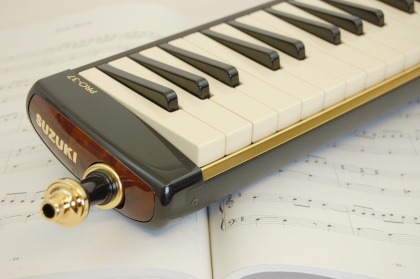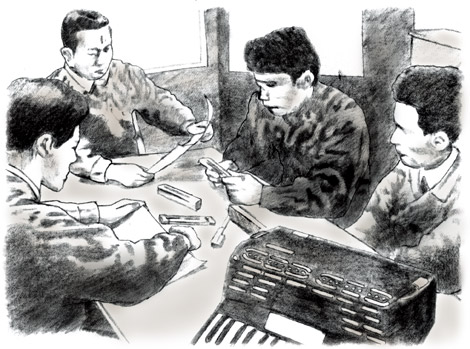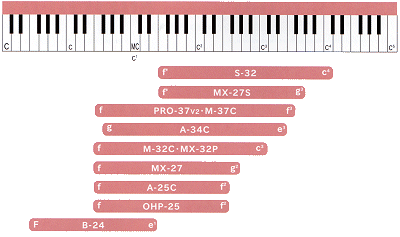Suzuki Melodions
 The
Suzuki Melodion; No other musical instrument combines so many
diverse playing techniques, such as keyboard skills, breath
control, as well as solo/ ensemble performance capability in a truly portable
instrument.
The
Suzuki Melodion; No other musical instrument combines so many
diverse playing techniques, such as keyboard skills, breath
control, as well as solo/ ensemble performance capability in a truly portable
instrument.
In Asia, the Melodion has become the primary instrument for music education, whilst in the West it has developed a new market with professional musicians and solo artists.
Whatever your musical tastes, a Suzuki Melodion offers an exciting addition to your instrument selection. Video demonstratios can be viewed here.
Using the navigation on this web page, select between the Melodion types. If you are a Solo performer we recommend Alto Melodions which cover the mid range with middle C located in the first Octave. Our amazing Bass Melodion is pitched in the two Octaves below middle C and is suitable not only for ensemble use, but a way to add a very cool and distinctive bass line to your performance.
The Andes stands out in its unique shape and sound. Unlike the traditional reed based Melodion the Andes employs pipes...25 of them to be exact.
The latest in Suzuki's line
takes the Melodion to a completely new level. The W37 made of
renewable wood is a true musical instrument in every sense. Enjoy
Jenny Russell's (The FB Pocket Orchestra) performance of Egyptian
Fantasy: A History Of Success
In 1954 development began of a new instrument, one that
could be used in ensemble or solo on a desktop. The aim was
to present an instrument suitable for teaching scales,
keyboard skills and breath control (useful for those moving
on to play woodwind and brass instruments). This proved to
be a great challenge due to the indirect way air moves
across the reeds. But finally Suzuki had an instrument that
was consistent across the keyboard range and easy for even
the youngest of students to play. The next two years were
spent conducting workshops and visiting schools across the
country to show the prototype instruments, demonstrating to
educators the benefits of Suzuki's new design.
Hard work and perseverance paid off when in 1956 the
Japanese Ministry of Education agreed to the adoption of
this exciting new design as the foundation instrument for
schools. By 1961 full scale
production began and The Suzuki Melodion was born. Soon,
almost every child in Japan would own one of these wonderful
instruments. Ongoing Development
Various types of materials have been used for the
instruments body such as resin covered metal.
Mouthpiece design has also changed in the past 50 years and
we now have a range of mouthpieces available to help perfect
your own playing style. Improvements in tonal 'colour' and
tuning make for better sound quality.
As a direct result of customer feedback, new models with
different number of keys have been developed and recently,
Melodions with a built in pickup (microphone) have opened up
a completely new direction for the professional musician.
We are confident the Melodion Story is far from over.
 From the 1930s, Japans Ministry of
Education had adopted the Harmonica as a primary educational
instrument and with great success. By the 1950s Mr. Suzuki
recognized the Harmonica had limits in certain aspects of
musical education; for example scales and keyboard skills.
Whilst the electronic organ would be useful as a teaching
instrument, it was both costly and too big for classroom
use.
From the 1930s, Japans Ministry of
Education had adopted the Harmonica as a primary educational
instrument and with great success. By the 1950s Mr. Suzuki
recognized the Harmonica had limits in certain aspects of
musical education; for example scales and keyboard skills.
Whilst the electronic organ would be useful as a teaching
instrument, it was both costly and too big for classroom
use.

Melodion Note Range
 Suzuki Melodions are voiced in three distinct ranges for ensemble playing: Soprano, Alto and Bass voices combine to produce full, vibrant sounds.
Suzuki Melodions are voiced in three distinct ranges for ensemble playing: Soprano, Alto and Bass voices combine to produce full, vibrant sounds.
For your convenience, here is a guide indicating the note range of each
instrument. This is particularly useful if you intend to purchase
instruments for ensemble use.
We recommend Alto Melodions for Solo use.
